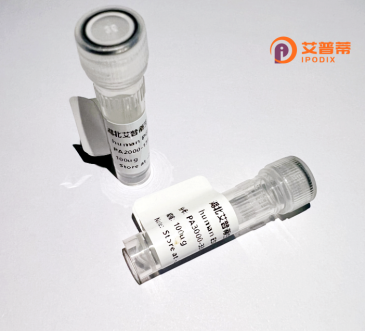
| 纯度 | >90%SDS-PAGE. |
| 种属 | Human |
| 靶点 | LGR7 |
| Uniprot No | Q9HBX9 |
| 内毒素 | < 0.01EU/μg |
| 表达宿主 | E.coli |
| 表达区间 | 68-162aa |
| 活性数据 | WSMQFDKYFASYYKMTSQYPFEAETPECLVGSVPVQCLCQGLELDCDETNLRAVPSVSSNVTAMSLQWNLIRKLPPDCFKNYHDLQKLYLQNNKI |
| 分子量 | 36.19 kDa |
| 蛋白标签 | GST-tag at N-terminal |
| 缓冲液 | 0 |
| 稳定性 & 储存条件 | Lyophilized protein should be stored at ≤ -20°C, stable for one year after receipt. Reconstituted protein solution can be stored at 2-8°C for 2-7 days. Aliquots of reconstituted samples are stable at ≤ -20°C for 3 months. |
| 复溶 | Always centrifuge tubes before opening.Do not mix by vortex or pipetting. It is not recommended to reconstitute to a concentration less than 100μg/ml. Dissolve the lyophilized protein in distilled water. Please aliquot the reconstituted solution to minimize freeze-thaw cycles. |
以下为关于重组人LGR7蛋白的3篇参考文献摘要信息,基于公开研究整理:
---
1. **文献名称**: *"The relaxin receptor is a crucial physiological regulator of pregnancy"*
**作者**: Hsu, S. Y., et al.
**摘要**: 该研究首次克隆并表达了重组人LGR7蛋白(松弛素受体),证明其在妊娠中通过介导松弛素信号调控子宫松弛和血管生成,为LGR7在生殖生理中的功能提供了直接证据。
2. **文献名称**: *"Recombinant expression and functional characterization of the human relaxin receptor LGR7"*
**作者**: Bathgate, R. A., et al.
**摘要**: 作者在哺乳动物细胞中重组表达LGR7蛋白,证实其通过激活cAMP信号通路响应松弛素刺激,揭示了LGR7与G蛋白偶联的分子机制,为药物靶点研究奠定基础。
3. **文献名称**: *"Structural insights into the ligand binding domain of the relaxin receptor LGR7"*
**作者**: Kong, R. C., et al.
**摘要**: 通过重组表达LGR7的胞外结构域并结合X射线晶体学,解析了其与松弛素配体的结合模式,阐明关键氨基酸残基对受体激活的影响,推动靶向药物设计。
---
**注意事项**:
- LGR7又名松弛素家族肽受体1(RXFP1),部分文献可能使用“RXFP1”而非“LGR7”,建议扩展检索关键词。
- 若需具体文献DOI或补充其他研究,可进一步提供方向。
Recombinant human LGR7 (leucine-rich repeat-containing G-protein coupled receptor 7), also known as relaxin family peptide receptor 1 (RXFP1), is a key receptor for the peptide hormone relaxin. Belonging to the class A GPCR family, LGR7 features a large extracellular domain with leucine-rich repeats (LRRs) that mediate high-affinity binding to relaxin. This receptor plays critical roles in reproductive biology, cardiovascular function, and tissue remodeling by activating signaling pathways such as cAMP and ERK1/2 upon ligand engagement.
Produced through recombinant DNA technology, LGR7 is typically expressed in mammalian or insect cell systems to ensure proper post-translational modifications and functional integrity. Its recombinant form enables detailed structural studies, ligand-receptor interaction analyses, and drug discovery efforts targeting relaxin-related pathways. Dysregulation of LGR7 signaling has been implicated in fibrotic diseases, preeclampsia, and heart failure, making it a therapeutic focus for tissue repair and anti-fibrotic interventions. Recent studies also explore its potential in cancer biology due to relaxin's role in tumor microenvironment modulation. The development of recombinant LGR7 has advanced pharmacological tools, including receptor agonists/antagonists and biomarker assays, while addressing challenges in receptor solubilization and stabilization for structural characterization. These advancements continue to illuminate LGR7's physiological roles and its translational potential in regenerative medicine.
×